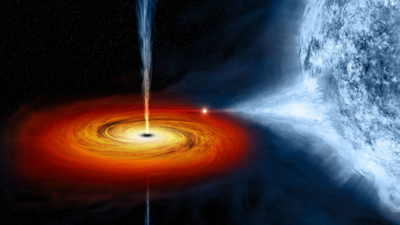Description

Source: TimesofIndia
Disclaimer: Copyright infringement not intended.
Context
- A recent study led by Oxford University researchers provided the first observational proof of plunging regions around black holes, affirming Einstein's theory of gravity.
- Published in the Monthly Notices of the Royal Astronomical Society, the study used X-ray data from NASA’s NuSTAR and NICER telescopes to analyze smaller black holes close to Earth.
- It confirmed the existence of plunging regions, where the strongest gravitational forces in the galaxy are exerted.
Details
- Plunging regions around black holes represent a key area where matter and radiation exhibit extreme behaviors due to the black hole's intense gravitational pull.
- These regions exist just outside the event horizon, marking the transition where material spirals inward and eventually crosses into the black hole, becoming irretrievable.
Key Concepts
- Event Horizon:
- Definition:The boundary around a black hole beyond which no information or matter can escape.
- Characteristics:Defines the Schwarzschild radius for non-rotating black holes and the Kerr radius for rotating ones.
- Innermost Stable Circular Orbit (ISCO):
- Definition:The closest orbit around a black hole where a particle can maintain a stable circular path.
- Significance:Inside the ISCO, orbits become unstable, causing material to spiral inward rapidly toward the event horizon.
- Accretion Disk:
- Definition:A disk of gas and dust that forms around a black hole as material falls inward.
- Inner Edge:Typically located near the ISCO.
- Emission:Heats up due to gravitational energy release, emitting radiation, especially in the X-ray spectrum.
- Plunging Region:
- Location:The area between the ISCO and the event horizon.
- Dynamics:Material loses stable orbits and spirals rapidly into the black hole, influenced by extreme gravitational forces and relativistic effects.

Characteristics of the Plunging Region
- Relativistic Effects:
- Gravitational Redshift:Light emitted from this region is significantly redshifted due to the intense gravitational field.
- Time Dilation:Time significantly slows down as observed from a distant observer's frame.
- Radiation:
- High-energy Emissions:Predominantly X-ray and gamma-ray emissions due to high-energy processes.
- Variability:Observed as material transitions from the accretion disk into the plunging region.
- Magnetic Fields:
- Acceleration of Particles:Strong magnetic fields can accelerate particles to near-light speeds, contributing to high-energy radiation and potentially relativistic jets.
- Dynamics:
- Tidal Forces:Extreme tidal forces stretch and compress matter.
- Angular Momentum Transfer:Viscosity within the accretion disk transfers angular momentum, allowing material to spiral inward.
Observational Evidence
- Gravitational Wave Detectors:
- Instruments:LIGO and Virgo.
- Role:Detect gravitational waves from black hole mergers, offering indirect evidence of dynamics within plunging regions.
- Event Horizon Telescope (EHT): Imaged the shadow of the supermassive black hole in the M87 galaxy, providing a view of regions near the event horizon.
Theoretical Models
- General Relativity:
- Framework:Einstein's theory describes gravitational effects in the plunging region.
- Metrics:Kerr and Schwarzschild metrics describe spacetime geometry around rotating and non-rotating black holes.
- Numerical Simulations:
- Purpose:Simulate behavior of matter and radiation in strong gravitational fields.
- Outcome:Predict observational signatures and improve understanding of black hole physics.
Importance in Astrophysics
- Black Hole Growth: Understanding plunging regions helps explain how black holes grow by accreting matter.
- Energy Release: Processes in this region are highly efficient at converting gravitational energy into radiation, impacting the surrounding environment.
- Relativistic Jets: Dynamics within the plunging region are linked to the formation of relativistic jets, influencing galaxy evolution.
Must read article:
Black Holes
Sources:
TimesofIndia
|
PRACTICE QUESTION
Q. The plunging region around black holes is a critical and dynamic environment where matter transitions from stable orbits to being swallowed by the black hole. Comment. (150 Words)
|











